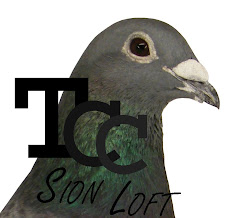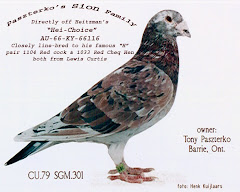This story is about a racing pigeon flying across the English Channel prior to D-Day.
Very few people know how many racing pigeons were used on the days just prior the biggest invasion, ever.
And few appreciate that many of the birds that were used were probably Sions or bloodlines related to such.
Secret notes went back and forth on the legs of the birds from England to the French Underground and vice versa.
Those notes helped save the world.
What you are about to read is just my imagination.
A little mess with truth .
But the truth is there, of what it must have been like.
Its different.
Blessings.
No Sweat
JUST MY IMAGINATION By Earl Lowell "Robbie aka "No Sweat" Robbins, Jr.
June 5,1944, Paris, France
But of course trees can cry, a building, too.
And these trees and the building had been so long heart broken that their tears were now gone.
For four years their tears had fallen.
And as anyone knows there are only so many tears.
Now, the gaiety of past times was but a faint memory and all that remained was a single panzer tank with its young soldier above the turret moving slowly up and down the Champs Elysees, zig zagging in its turns.
Oppression's barrel.
A tiger?
In earth's ores.
Yes.
Oh, but the trees on both sides of that special avenue for more than a mile did weep.
Their green more grey but green still.
Little wings slicing through a grey dream.
This is a dream is it not?
Grey wings still.
And grey dream, more.
But not so grey, no.
Camouflaged hope.
Hope comes that way.
Is it not true?
From son to father little wings flew, Robert Sion to Paul Sion.
Son in London, father in France.
From son itself in feather one loft to its own father in another loft as well.
And more.
Home.
A pigeon knows its father, though such secret but true.
What path truer could there be?
Blood flying to blood.
212 miles from London to Paris.
Where else could a pigeon go so unnoticed?
Where else indeed.
The most common bird in the world in a very uncommon way.
A million lives in those wings.
No, tens of millions.
What message does it own?
Camouflaged hope, indeed.
The three pigeons on the Arch de Triomphe paid little mind to the tank.
Those pigeons knew nothing of little wings slicing.
They were diversions at nature's smile.
Two of the birds were dark some, the other, white;
Two males and a hen in that ancient contest of love.
The males on either side, bent forward, tails spinning, frantically cooing, suitors oblivious except for each other.
She pretends not to see them, almost.
Nearly still, she is indifferent to their strutting and show.
But she is watching, yes
Spin small bird.
Man remains jealous.
"THE COW SKIPPED OVER THE SUN SIX HUNDRED AND SIXTY SIX TIMES," says little wings' secret message:
Coded: "D-DAY, JUNE 6."
Winds in little wings slicing face, waves below, clouds encompass.
Yes, that nowhere to land English Channel.
Death's gaping jaws.
A homing pigeon comes home.
A racing homer makes an art of it.
Home owns its heart unlike any other.
Feathered serpents fly far beyond the Galapagos, do they not?.
They see what man doesn't and feel what he can't.
The best messages are felt.
But Little Wings Slicing compared.
A message to save the world.
And all, yeah, on the leg of a poor pigeon.
And what of the face of the French Resistance?
Have you seen a bird smile in the sun?
Have you seen sparrows attack hawks?
Have you watched birds in a storm?
You see then the face of resistance.
Vestal Virgins waiting for their pigeon.
Noah waiting for that dove compounded.
Beneath those pigeons on the Arc de Triomphe, those common pigeons of little note, was a large shield lying on the ground and on that shield was a sword;
France's Tomb of the Unknown Soldier;
An eternal flame burning there.
Camouflaged hope.
A flame of yellow and sometimes red matching the colors in the eyes reflecting off little wings slicing as he follows his brother.
A brother not seen but there.
No markers in the sky or on the water.
Just following a feeling.
June 1.
That's when the brother of Little Wings Slicing flew.
The British and Americans were boarding.
June 5 was to be the day.
Then came the storm, that crucial eye on time and place in peril.
That exact full moon and that exact spring tide so in fate, so crucial.
Descendant from Lascaux was little wings slicing.
Jupiter's son.
And long before all that the men as well.
All from the sea but such diversions at survival's mold.
One with feather, the other with barrel.
And before the sea?
Do galaxies not make war?
The three pigeons on the Arc de Triomphe lifted and flew.
The hen's wings beating steady as her suitors V-winged glided.
Each landing on a shield high atop, Napoleon's Austerlitz engraved there on.
So queer that birds don't keep flying beyond the dream.
Queer too, how the sun's passing messes.
Allies changing with rotating shadows.
Could General Vandamme forecast a common pigeon courting on his memory?
Did Napoleon's artillerists throw a wooden statue of the Virgin Mary into a fire for warmth and it wouldn't burn?
That demure hen, smaller than her suitors, head cocked looking with one eye down at France's Elysian fields, that impressive promenade, seeing the tank.
As if some louse in her wing.
A pigeon sees clearer than man, does it not?
Man to pigeon, pigeon to man.
Silent wings would follow in the form of poor gliders as Basque berets with a pigeon feather brooch, destroyed railroads, bridges and fear.
Later roosting on The Croix de Lorraine.
To touch your son's words, to save your home, to dream of tomorrow.
Paul Sion, bald, mustached, a drifter in a white collar, maybe so, more common than the most common of pigeon, waited at the open window.
Beside him, another Maquis in a black beret.
Grey eyes in the grey.
But a heart not so.
Such a difference in a pigeon's coo and the sound of a gun.
One velvet, soft and powdery.
The other, time's revenge.















